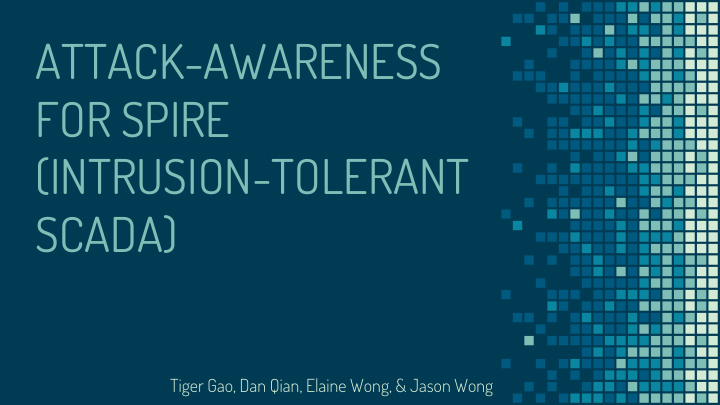



ATTACK-AWARENESS FOR SPIRE (INTRUSION-TOLERANT SCADA) Tiger Gao, Dan Qian, Elaine Wong, & Jason Wong
1. BACKGROUND What is Spire? What is SCADA?
What is SCADA? Supervisory Control and Data Acquisition ▪ Allows for centralized control over systems that are ▪ spread out over large distances Monitors and controls devices that collect information ▪ from and interact with the physical world such as power breakers, valves, HVAC controllers, factory machine computers Used widely in critical infrastructure: ▪ Electrical grids, water treatment facilities, power ▫ plants buildings, factories, facilities etc. 3
SCADA System Layout PLCs/RTUs ▪ Sensors and/or control units ▫ Closest level of interaction with process ▫ SCADA Master ▪ Coordinates network of PLCs/RTUs ▫ HMI ▪ Interface through which human operators can ▫ monitor and give commands to the system
Current SCADA Vulnerabilities Use in critical infrastructure makes SCADA systems ▪ valuable targets to attack, especially by state actors Stuxnet ▫ Compromised SCADA systems can disable or potentially ▪ permanently destroy critical infrastructure 2015 Ukrainian Power Grid Attack ▫ Power cut for 230,000 people ▫ Transition from closed networks to IP exposes SCADA ▪ systems to the internet, easier to attack Experiment with honeypot of PLCs were attacked 39 ▫ times from 14 countries in a month(Aron)
What is Spire? Spire is an open-source, intrusion ▪ tolerant SCADA solution over IP Many components work together to ▪ prevent attacks Spines: Networking ▫ Prime: Timely Byzantine Fault ▫ Tolerance Multicompiler: Entropy ▫ Scheduled Resets ▫ RTU/PLC Proxy ▪
How It Actually Works
Effectiveness - Does It Work? Short Answer: ▪ Resisted an extensive attack by a Sandia National ▪ Laboratories Also retains timeliness consistently, with some variations ▪ because of special circumstances
2. OUR WORK Introducing attack-awareness to an intrusion-tolerant system
Attack-Awareness Spire handles many attacks silently, without notifying a ▪ human operator Bad leader in byzantine agreement protocol ▫ Dumb DDoS attacks (from compromised device) ▫ These problems could be easily resolved with human ▪ awareness (i.e. unplugging a compromised master) Our goal: Displaying HMI alerts to notify operators of ▪ ongoing attacks of different types 10
Attack Types of Note DDoS Attacks Bad Leader Attacks Dumb attacks from adversaries A compromised SCADA master ▪ ▪ who may have compromised part who leads the agreement of the system and are spamming it protocol sends inconsistent with random messages messages to other masters, delaying instruction execution Can happen at HMI, proxy, and ▪ firewall levels This occurs inside prime ▪ 11
What We Have Accomplished (Part I) First few weeks: Just getting to know the code ▪ Exploring the codebase, learning about Spire in ▫ general Setting up VMs to work with HMIs on PVBrowser ▫ Getting to know PVBrowser ▫ ▪ Then: Learning how to set up the full system (HMIs, PLCs, SCADA masters, oh my!)
What We Have Accomplished (Part II) First: A plain alert message on HMI for internal DDoS attacks ▪ This later became a table displaying which SCADA master is ▪ spamming the HMI, and is therefore the compromised machine Similarly, we display an alert when the proxy is being ▪ spammed Adding an alert for bad leaders in the Prime agreement ▪ protocol Adding logging for possible firewall spam ▪
DEMOS!!!!! 15
Challenges ▪ Getting through the codebase ▪ PVBrowser/Ubuntu/Centos issues with freezing ▪ Mostly, didn’t/haven’t had enough experience with the system to develop an intuition of where different kinds of bugs could be coming from Weird problems like clock synchronization for Spines ▫ communication or temp files that we needed sudo access to delete Sometimes just had to restart the whole thing ▫
Future Work Generalizing the alert system ▪ Ex. There are a lot of places where Prime can detect ▫ suspicious activity, but doesn’t alert Detecting replay attacks (a less dumb DDoS attack) ▫ which forces system to decrypt before discarding message Integrating logging for firewall spam into the HMI ▪ Cleaning up; this was mostly proof of concept ▪ 17
THANK YOU to Amy Babay , for setting us up, coming to our meetings, guiding us through code and bugs to Sam Beckley , for helping us get started with the HMI to Yair Amir , for giving us the opportunity to work on this incredibly impactful and important project 18
Recommend
More recommend